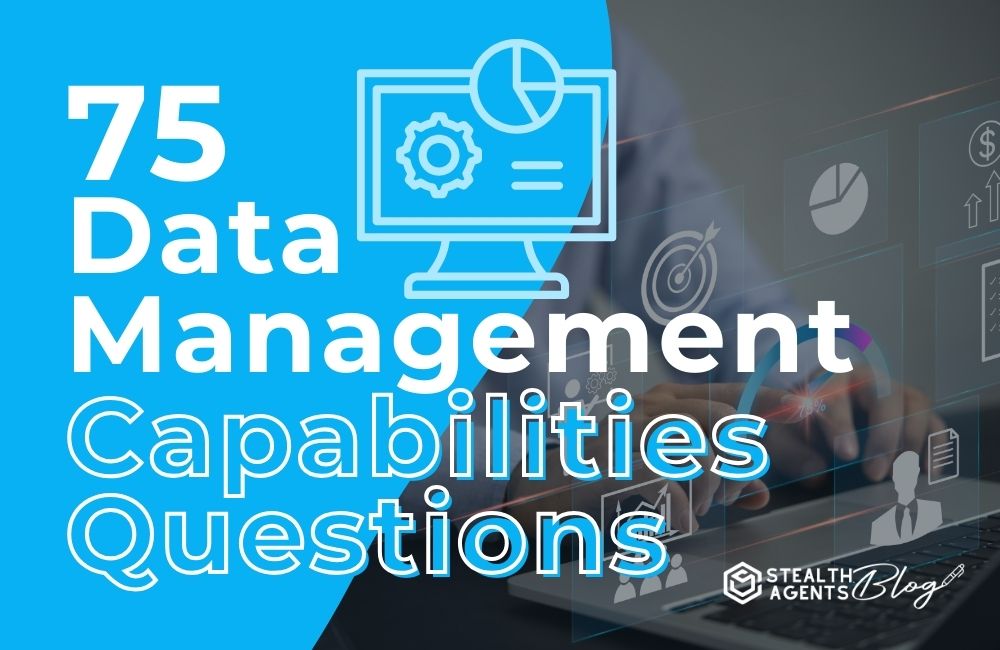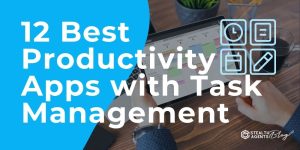Talking about data in today’s business world is absolutely crucial. It’s not just the buzzword of the decade; it’s the foundation of countless successful companies and the engine propelling them forward into a data-driven future.
But how do you make sense of it all? Where do you start when it comes to controlling, analyzing, and protecting the data that drives your operation?
Don’t worry, because I’ve got you covered. Below is a comprehensive list of 75 Data Management Capabilities Questions you need to ask yourself.
Think of it as your personal checklist as you step into the world of managing, understanding, and, most importantly, leveraging your data. Let’s dive in!
Importance of Data Management
Data management is a critical aspect of modern businesses and organizations, underpinning their ability to operate efficiently, innovate, and compete in a data-driven world.
It involves the collection, storage, organization, and analysis of data to ensure its accessibility, reliability, and timeliness.
The importance of data management stems from its role in supporting decision-making processes, improving operational efficiency, ensuring compliance with regulations, and enhancing customer satisfaction.
By implementing robust data management practices, organizations can leverage their data assets to gain insights, identify trends, and make informed decisions that drive strategic business outcomes.
Effective data management is not just a technical necessity but a strategic asset that can lead to competitive advantage, operational excellence, and improved business performance.
The Foundation: Data Foundations and Architecture
When building your data management strategy, it all starts with a solid foundation. This means defining how you collect and store your data in a structured and future-proof way. Answer the following questions:
-
How is your data currently structured?
-
What kind of data does your business utilize (e.g., transactional, master, metadata, operational)?
-
What hardware and software are you using for data storage and management?
-
Does your data architecture support current and future data needs?
-
Do you have a data governance framework to maintain data quality and integrity?
-
How do you manage access and permissions within your data storage systems?
Data Ingestion: The Process of Collecting Data
Data must be collected before it can be managed. This is called data ingestion, and it’s not as straightforward as it may seem. To understand your ingestion capabilities, ask:
-
How do you collect and bring in new data sets?
-
Are you able to collect data from both structured and unstructured sources?
-
Do you have processes for the efficient transfer of the data from its source to storage?
-
What is your strategy for real-time data ingestion?
-
Can you handle high volumes of data coming in at a rapid pace?
-
What are the checks in place to ensure data accuracy at ingestion?
Storage: Safeguarding Your Data
Your data holds value, and like any valuable asset, it needs protection and smart storage. Here’s what you need to know about your data storage capabilities:
-
What is your strategy for storing historical and current data?
-
Where is the data stored (on-premise, cloud, hybrid)?
-
Do you have a data retention policy in place?
-
How do you ensure the security of your stored data (encryption, access controls)?
-
What measures do you have for data redundancy and disaster recovery?
-
Is your storage solution scalable to meet the growing needs of your business?
Processing: Turning Data into Insights
Data that sits idle is data wasted. For your business to thrive, you need to process your data effectively and efficiently. Here’s how to evaluate your processing capabilities:
-
What big data processing frameworks do you use (e.g., Hadoop, Spark, Flink)?
-
How do you manage and execute data processing jobs (on-premise, cloud, or both)?
-
Do you have a process for transforming data (ETL), if necessary?
-
What methods do you use to prevent data bottlenecks during processing?
-
Are you engaging in real-time or batch processing or a mix of both?
-
How do you balance processing speed with data accuracy?
Governance: Keeping Your House in Order
Data governance is the set of practices and strategies you have in place to ensure that your data is managed effectively and responsibly. Here’s what you need to consider:
-
Do you have a designated data governance team or officer?
-
What policies and procedures are in place to guide data usage?
-
How do you ensure compliance with data regulations (GDPR, CCPA)?
-
What is your data lifecycle management strategy?
-
How do you enforce data policies, and what tools do you use for this?
-
How often do you conduct audits of your data governance structure?
Master Data Management: Unifying and Harmonizing Your Data
Master Data Management (MDM) is the method to define and manage the critical data within an organization. When evaluating your MDM capabilities, ask:
-
How do you identify and curate master data within your organization?
-
What tools do you use for data modeling and mapping (e.g., MDM software)?
-
Do you have a single, authoritative source for key data elements?
-
How do you handle data duplicates and inconsistencies?
-
What methods or policies do you have in place for data validation?
-
What do you do to ensure that master data is synchronized across systems?
Data Quality Management: Ensuring Accurate and Reliable Data
The quality of your data is of utmost importance. Bad data can lead to bad decisions. To assess your data quality management capabilities, consider:
-
How do you define data quality within your organization?
-
What are the most common data quality issues you face, and how are they typically resolved?
-
What measures do you have in place to maintain and improve data quality over time?
-
How do you define and measure data quality metrics (e.g., accuracy, completeness, consistency)?
-
What tools and technologies do you use to manage data quality?
-
How do you ensure that data is fit for its intended use?
Metadata Management: The Data About Your Data
Metadata management is the management of information about other data. This includes discovering, storing, controlling, aggregating, and using metadata. To assess your metadata management, ask:
*advertisement*
Tired & Overwhelmed With Administrative Tasks?
Hire A Top 1% Virtual Assistant From Stealth Agents!

Sign Up Below & Hire A Top 1% Virtual Assistant
Rated 4.7 Stars Serving Over 2,000+ Customers.
Hire Top 1% Virtual Assistants For $10-$15 Per Hour
Ask About Our 14 Day Trial!
*advertisement*
-
How do you capture and store metadata information?
-
What metadata standards do you use?
-
Are you able to connect and access metadata from different sources and systems?
-
What is your strategy for ensuring metadata consistency and accuracy?
-
How do you leverage metadata to discover and manage your data assets?
-
Do you have a process for analyzing metadata to gain insights into your overall data environment?
Data Security: Protecting Your Most Valuable Asset
Data security is not just one of the most important capabilities but also one of the most challenging. To evaluate your data security capabilities, ask:
-
What security measures do you have in place to protect your data at rest and in transit?
-
Are your security policies in line with industry standards and best practices?
-
Do you have a data classification process for sensitive and confidential data?
-
How do you monitor and manage user access to sensitive data?
-
What measures do you have in place to protect against data breaches (e.g., intrusion detection systems)?
-
Do you train your employees regularly on data security best practices?
Data Privacy: Guarding People’s Information
With privacy regulations like GDPR, CCPA, and others, ensuring data privacy has never been more important. To evaluate your data privacy capabilities, consider:
-
How do you ensure that you collect and process data in accordance with privacy regulations?
-
Do you have a process for handling data subject requests (e.g., for data deletion or access)?
-
What tools do you use to manage data privacy compliance and requests?
-
Are your privacy policies and practices transparent to individuals whose data you process?
-
How do you safeguard sensitive personal information against unauthorized access or use?
-
How do you effectively communicate changes to your data privacy practices to affected individuals?
Compliance: Navigating the Regulatory Minefield
In addition to privacy regulations, there are many other regulations that may affect how you manage your data. For compliance capabilities, ask:
-
Do you have a thorough understanding of all data-related regulations that affect your organization?
-
Are your data management practices regularly audited for compliance?
-
How do you ensure that your data management processes evolve to stay compliant with changing regulations?
-
Do you have a strategy for managing and reporting data usage to regulatory bodies (e.g., for financial or healthcare data)?
-
What measures do you have in place to ensure that data is stored and managed according to specific regulatory requirements (e.g., data localization)?
-
How do you track changes in regulations and adjust your data management processes accordingly?
Integration: Making Data Useful Across the Business
Your data has the most value when it’s integrated and accessible across your entire organization. For evaluating your integration capabilities, consider:
-
How do you integrate data from different sources and formats?
-
Do you have an Enterprise Service Bus or other integration middleware in place?
-
How do you make sure that integrated data is consistent and up-to-date across systems?
-
What measures do you have for integrating data coming from newly acquired businesses or systems?
-
Do you utilize data integration platforms to simplify and automate integration flows?
-
How do you ensure that sensitive data is appropriately handled throughout the integration process?
Collaboration: Sharing Data Effectively
In collaborative environments, the ability to share data securely and efficiently is key. To assess your collaboration capabilities, ask:
-
What tools do you use to share data within your organization (e.g., data lakes, collaboration platforms)?
-
How do you maintain control over data sharing, both internally and externally?
-
Do you have collaboration policies and best practices in place to guide your employees on data sharing?
Conclusion
Phew! That’s quite the checklist, isn’t it? But remember, it’s not about answering all these questions perfectly. It’s about identifying your strengths and weaknesses so you can chart a course for your data management that’s grounded in reality and ready to evolve.
As you work your way through these questions, you will begin to see where your data management capabilities shine and where they could use a little polish. This process will set you on the right path to turning your data into one of your company’s most valuable assets. It’s no easy task, but data is the future, and by harnessing it, you’re positioning yourself and your business at the forefront of a data-driven economy.
So go on, dive into this list, and start unlocking the power of your data. Your company’s future could depend on it.










